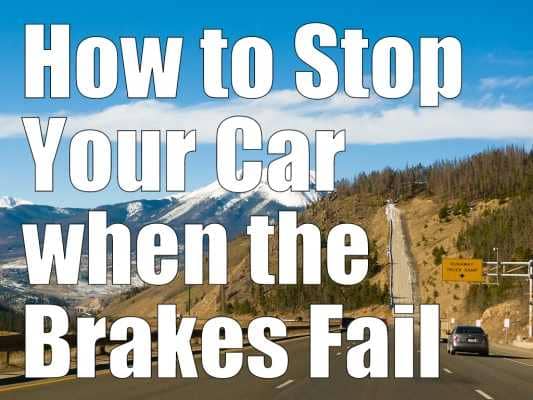The Recycled Part

You've experienced it, heard about it, or had nightmares...
You're on your morning commute and as you approach your exit, you turn on the right blinker, check your mirrors (hopefully), and press the brake pedal to slow down in preparation for the turn, and...it goes all the way to the floor with little resistance as if you just stepped on a marshmallow! Then comes the adrenaline. Your heart rate shoots to 180 bpm. Pupils dilate. You check the mirrors, a semi is coming on fast. This is it, the end. You've had a good run.
Well it's not over, yet. There are a some emergency measures to employ. We adapted the following nine steps from WikiHow. They may be the closest thing to casting a magic spell to stop your car.
-
Don't panic. Calm down. Overreacting will only jeopardize your chances of survival even more.
-
Consider how your brake pedal "feels." If it's soft you may be able to revive some braking force by pumping the brakes. If your brake pedal feels hard, you could have an obstruction under your pedal. Check it out with your foot or have a passenger look.
-
Pump your brakes repeatedly. This may rebuild enough braking pressure to stop the car. Keep at it, it may take a while. When you feel pressure built up, quickly press the brake pedal all the way down. Keep the brakes squeezed to the floor. Hydraulic brakes rarely fail *completely*.
-
Progressively downshift into low gears. Use your engine to slow the car. For an automatic transmission, downshift one gear at a time into the lowest gear. For a manual transmission, downshift one, or two at the most, gears at a time. Use caution, rapid downshifts into second or first gear can cause you to lose control of the vehicle.
-
Pull the “E-brake.” Your emergency brake, or parking brake, might stop your vehicle. However, it only engages the rear wheels so it may work slowly. Caution! If applied too forcefully, the emergency brake can lock your rear tires, especially at high speed. If your tires lock, release some pressure from the brake, hold it, then apply more pressure as the vehicle decelerates.
-
Keep your eyes on the road and be aware of your surroundings. Other drivers and pedestrians are likely unaware of your emergency. Alert them with your hazard lights and sounding your horn. Roll your windows down to increase air drag as well as make it possible to shout if needed.
-
Steer sharply from side to side. Turning naturally slows your vehicle as it creates friction between your tires and road surface. If you have sufficient room, do this repeatedly but carefully. Caution! Do not do this at high speeds. You can flip or spin your car.
-
As a last resort, use the surroundings to slow your vehicle. These techniques can be very dangerous, especially at high speeds.
-
Dirt, gravel, grass, or sand on the road's shoulder offer increased friction to slow your car down. Carefully and gently pull your vehicle onto a shoulder.
-
Look for an incline to drive your car up. Use gravity to your favor.
-
Look for a guardrail or cement divider to sideswipe. A pear-shaped cement divider is preferable; they are designed to contact your tires before your vehicle's body.
-
Look for small trees or shrubbery you can drive through. Caution! Trees more than four inches in diameter are dangerous!
-
-
If all the above steps failed, look for a spot to safely crash. You have two options; a single-vehicle crash and a two-vehicle crash.
-
For a single-vehicle crash, first slow your vehicle down using the above methods. Steer your vehicle onto the shoulder or center divider and look for an object to impact squarely after you have reduced speed.
- For a two-vehicle crash, look for another vehicle moving close to your speed and that has a bumper about the same height as yours. Aim to hit the vehicle as square as possible on the rear bumper. Hitting another vehicle at an angle can send you both out of control. Lastly, warn the other vehicle by sounding your horn and flashing your lights.
-